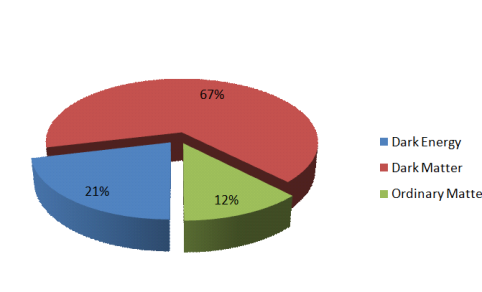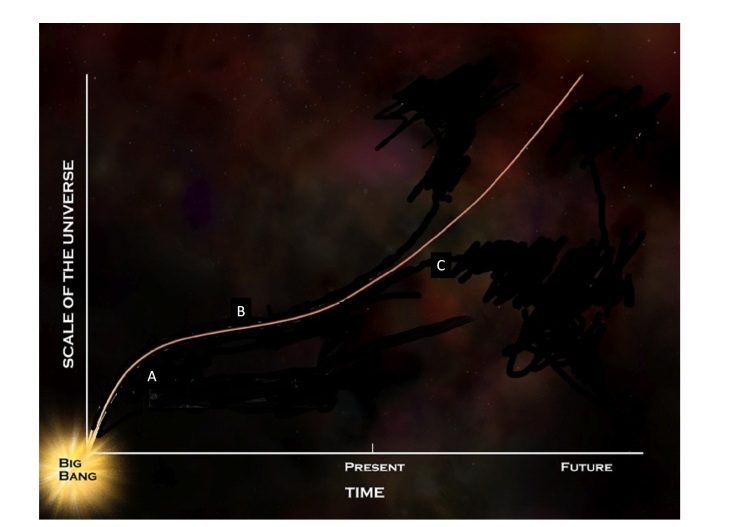This post continues the subject of dark energy, which, as discussed in my previous post is a mysterious form of energy which makes up about 68 per cent of the mass of the Universe and is the reason why the Universe is expanding at an ever-faster speed. This post will discuss how the percentage of dark energy changes over time and how this has influenced and will influence the evolution of the entire Universe.
This post is the fourth in my series on cosmology, the study of the origin and evolution of the Universe as a whole. To view the others please click on the category “Cosmology” at the end of this post.
The influence of dark energy in the early Universe
As mentioned in my previous post, cosmologists have estimated that the amount of dark energy in the Universe works out at about 0.0069 trillionths of a gramme per cubic kilometer of space, about 150 billion times smaller than a small grain of sand. Although this amount is incredibly small, it is still considerably greater than the average density of matter. The most widely accepted explanation of dark energy, the cosmological constant, means that the amount of dark energy in a given volume of space remains constant over time.
The expansion of the Universe is shown in the diagram above, in which the x-axis shows time. It illustrates that, in the distant past, galaxies were much closer together than they are now.
In fact, if we go back in time roughly 7 billion years then, on average, the distance between galaxies was roughly half what it is today.
As shown in the diagram above, when galaxies were two times closer together, the same number of galaxies took up a volume eight times smaller. the density of matter (which is equal to mass divided by the volume) was therefore eight times higher. However, the density of dark energy was exactly the same as it is now. This is shown in the first and third columns of the table and in the pie-chart below.
The percentages of dark matter, dark energy and ordinary matter in the Universe when it was seven billion years old.

If we travel back further and further in time, the density of ordinary matter and dark matter gets progressively higher and higher, because the same amount of matter is in a smaller and smaller space. However, because the density of dark energy is constant, its percentage contribution to the total mass of the Universe gets smaller and smaller. When the Universe was one tenth its current size then dark energy made up only 0.2% of the total mass of the Universe and at times earlier than this its contribution was insignificant. It is therefore clear that, although it dominates the Universe now, dark energy was completely unimportant in the early Universe and played no part in its initial expansion. The current most widely accepted explanation of the initial expansion of the Universe is that, in the first microscopic fraction of a second after the Universe came into existence, it underwent an incredibly rapid expansion called inflation. After this first minute fraction of a second had passed, inflation switched off and the Universe has been expanding ever since. The exact details of this process are still not fully understood.
The diagram above shows how the Universe expands over time. The Universe expands rapidly after the big bang, but all the time its expansion is slowed by gravity (A). About 7 billion years ago, it is still expanding but its rate of expansion is at a minimum (B). After this time dark energy dominates the Universe and its expansion speeds up (C).
Dark energy in the future
As the Universe expands, and the galaxies get further and further away from each other, the density of ordinary matter will continue to fall. In roughly 10 billion years the Universe will have expanded so that the distance between galaxies will be roughly twice what it is today. This means that because we will have the same amount of matter in a space eight times bigger than it is today, the density of matter will be roughly one eighth.
Because the amount of dark energy in a given volume of space remains the same as the Universe expands, it will make up an even greater proportion of the total mass of the Universe than it does now. This is shown in the pie-chart below.
As the Universe continues to evolve and expand, the contribution of dark energy which accelerates its expansion will continue to get greater and and greater. In fact, in around 30 billion years time when the average distance between galaxies is roughly 10 times its current value, it will consist of 99.95% dark energy.
I will say more about the ultimate fate of the Universe in a future post. As we go further forward in time to around 100 billion years from now, about 7 times longer that the age of the Universe, the distance between our galaxy and other galaxies will be so great that the light from them won’t be able to reach us (see notes). If there are any astronomers in our galaxy at this time then when they look out with their telescopes then rather than seeing hundreds of billions of galaxies in the observable universe that they do today they will only see a single large galaxy – our own.
Next Post
My next post will be about dark matter, the mysterious substance which makes up about a quarter of the Universe, but about which we know very little indeed.
Related Posts
This post is the fourth my series about cosmology. The other posts are:
(1) The Universe Past, Present and Future. This describes what is meant by the Universe and gives an overview of its origins, evidence for its expansion and discusses its ultimate fate. To view this post click here.
(2) A brief history of the Universe. This gives a history of the Universe from just after the big bang until the current date. To view this post click here.
3) Dark Energy. This post gives the reasons why cosmologist believe dark energy exists and why it makes up nearly 70% of the mass of the Universe. To view this post click here.
Notes
Strictly speaking not all galaxies are getting away from us. Our own galaxy the Milky Way and its neighbour, the Andromeda galaxy, together with a number of small satellite galaxies form a group of galaxies called the Local Group. The galaxies in the local group are bound together by the force of gravity so they won’t get further away from each other as the Universe expands.
However, the Milky Way and the Andromeda galaxy are on a collision course. The Andromeda galaxy is approaching the Milky way at 400,000 km/h and they will collide in roughly 5 billion years time to form a giant galaxy. So in in around one hundred billion years time our observable Universe will consist of a single galaxy.






[…] (4) Dark Energy over Time. This post discusses how the amount of dark energy in the Universe has varied over time and its implications on its future evolution. To view this post click here. […]
LikeLike
Very interesting. Will have to peruse your blog soon.
LikeLike
[…] complex scientific subjects in very easily understood terms. He is doing a series on cosmology and dark matter that allowed me to actually get it and why what makes 68% of our cosmos is really something I […]
LikeLike
Reblogged this on bertpowers and commented:
Informative.
LikeLike
If the amount of dark energy in a given volume of space stays constant whilst the universe expands that implies that more dark energy must be created. How does this tie in with the law of conservation of energy – Energy can neither be created nor destroyed?
LikeLike
Reblogged this on msamba.
LikeLike
I am enjoying your posts very much, and here I followed your argument very carefully. However, I do think that your conclusion “… dark energy …. played no part in its initial expansion” is something of a non-sequitur. We don’t really know for sure, do we?
LikeLike
Thanks for your comment and I’m glad you’re enjoying my blog. What I am saying is that the most widely accepted explanation of dark energy, the cosmological constant, means that all space has a very small amount of energy which causes it to gradually expand. This value doesn’t change over time and is the same throughout the Universe. Because the cosmological constant is so small it was only able to speed up the Universe’s expansion when the density of matter had fallen low enough for the speeding up of the expansion (caused by the cosmological constant) to be greater than the slowing down of the expansion (caused by gravity).
As stated in the post if we were to go back in time to the early Universe when the density of matter was much higher than it is now, then, assuming that its value doesn’t vary with time, the percentage contribution of dark energy (caused by the cosmological constant) to the Universe would have been tiny.
For example, when the Universe was around 400, 000 years old, the average density of matter would have been 1 billion times higher than it was today, but the density of dark energy (caused by the cosmological constant ) would have been exactly the same as it today. So, at this time, only about 2 billionths of the mass of the Universe would have been in the form of dark energy.
The obvious question to ask then is: what caused the extremely rapid expansion after the Universe first came into existence ? The current explanation is that it underwent an extremely rapid expansion from something many orders of magnitude smaller than an atomic nucleus to about 10 cm in diameter in the first 0.00000000000000000000000000000001 second of its existence. This is called inflation and is accepted by the majority, (but by no means all) cosmologists. The actual mechanism by which inflation occurred (if it did) lie deep in the realms of particle physics, but I considering writing a post about it aimed the non-scientist. This will be quite a challenge !!
The Science Geek
LikeLike
Excellent Post – will b coming back to study this a few more times!
This should keep u entertained:
http://bradscribe.wordpress.com/2014/03/22/cosmic-latte/
Cheers!
LikeLike
Thanks
glad you enjoyed the post
LikeLiked by 1 person
Amazing. Just discovered your fantastic blog, and I love it.
One question on the post – there is a clear distinction between dark matter and dark energy. I have always viewed mass and energy as inseparable concepts. So every object contains energy within. What do I miss here?
Thank you for your great post.
LikeLike
Thanks for reading (and enjoying !) my blog. In my posts I have carefully used the term dark matter and dark energy. Essentially all physical objects are made up of matter, and matter is something has both a mass and volume (and thus takes up space). All everyday objects are made up of ordinary matter which is composed of atoms.
All matter has some degree of energy. Examples of energy are: heat, light, kinetic energy (energy from movement), potential energy (e.g. the energy you gain when you climb to a top of a hill). Dark energy is a hidden form of energy which makes the Universe expand faster. Dark matter is something entirely different which I’ll talk about in a future post
The Science Geek
LikeLiked by 1 person
Thank you. I was confused with the separation of matter and energy because (as I’ve also believed) every object contains energy within (not outside).
Looking forward to your future posts. (Though there is still plenty of cool stuff that you already posted that I need to check out).
Good luck!
LikeLike